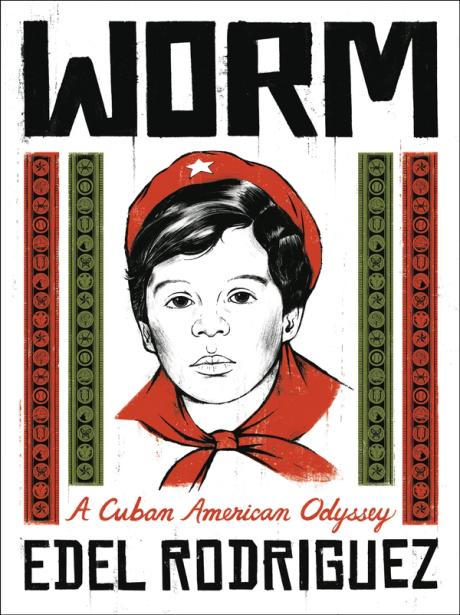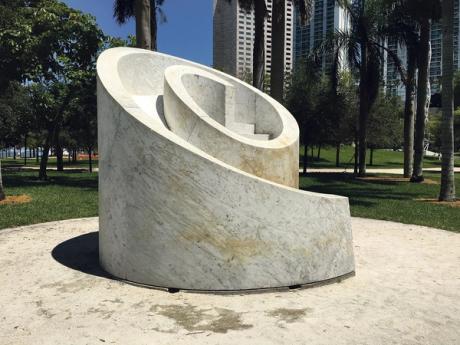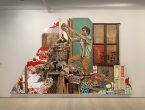Aqua
2015 - Installation (Installation)
Dimensions variable
Fernando Palma Rodríguez
Aqua by Fernando Palma Rodríguez is an installation formed by four gourds and one movement detector that activates them. Once put in motion, the gourds open and close hinged hands that are cut from their bodies, catalyzing a sophisticated, choreographed conversation among them. Following Indigenous notions of personhood, Palma Rodríguez grants agency to ordinary objects and therefore the ability to relate to others—humans as well as non-humans. In this case, the gourds (guajes o bules in Spanish), made from the fruit of Lagenaria siceraria , which have been used since pre-colonial times as containers, communicate with each other. These ancestral flasks stand for the importance of the liquid they can potentially contain, their materiality being eloquent enough as a narrative element that is further enlivened by their movement. Their conversation addresses concerns for the stress water sources have been put under to supply the largest city in Latin America, affecting important ecosystems. Through the use of robotics, Palma Rodríguez relates to Western technology in a critical way, acknowledging its logics, but turning its potential against its fixed assumptions of progress and development that have often marginalized non-Western understandings. Instead of creating neat mechanisms of deception, he exposes the basic devices he uses to animate his works, going against the grain of what Bruno Latour has called blackboxing , the process by which science and technology’s innerworkings become more obscure as their outcomes gain visibility.
Fernando Palma Rodríguez was born in the rural area of Milpa Alta, Mexico City and his practice is intimately related to this place. After living in the United Kingdom for three decades, Palma Rodríguez returned to Mexico ten years ago and establish himself back in Milpa Alta where he develops his artistic practice as well as the project Calpulli Tecalco, with his mother Carmen Rodríguez Meza, and sister, María Angélica Palma Rodríguez. Calpulli Tecalco is a not-for-profit organization dedicated to the preservation of the ecological wealth of the area through the milpa—an ancient native agricultural system—as well as the teaching of Nahuatl. Palma Rodríguez’s practice is influenced by his initial training as a mechanical engineer, but also by his interest in Mesoamerican Indigenous thought, past and present, and by the process of learning Nahuatl, the language of his elder relatives that he only learnt as an adult through tape recordings his uncle sent to London. He articulates his interest in science, robotics, and programming with an artistic practice informed by environmental and cultural activism. His work purposefully adopts rudimentary technologies that yield precarious animated sculptures made out of found waste, stones, earth, and vegetation that bring back to life elements and narratives of Mesoamerican cosmologies, which the artist links to present day situations.
Colors:
Related works sharing similar palette
» see more

© » KADIST
Olivia Erlanger
2016Sideways Time by Olivia Erlanger is the result of the artist’s interest in networks, seen and unseen, financial and ecological, the collapse of which has resulted in the fracturing of a middle class American identity...

© » KADIST
Gimhongsok
2007To explore the boundaries between artwork and audience, Gimhongsok created a series of sculptural performances in which a person wearing an animal costume poses in the gallery...

© » KADIST
Candice Lin
2015For the work Wigan Pit-Brow Women: Intersections with the Caribbean (mobile) , Candice Lin studied English Victorian Arthur Munby’s racialized and masculinized drawings of working-class white female miners...
Related artist(s) to: Fernando Palma Rodríguez » Minerva Cuevas, » Adriana Bustos, » Agnes Denes, » Allan Sekula, » Andrea Bowers, » Andrea Geyer, » Anna Bella Geiger, » Anne Wrinkle, » Antonio Vega Macotela, » Blue Curry
» see more

© » KADIST
Minerva Cuevas
2006During her research on primitive currencies and cultural cannibalism, Cuevas came across the Donald Duck comic book issue “The Stone Money Mystery,” where Donald goes on a quest to find missing museum objects...

© » KADIST
Adriana Bustos
2018El mar y sus múltiples afluentes (The Sea and its Multiple Tributaries) builds on the concept of trafficking that Adriana Bustos has been exploring over the last decade...

© » KADIST
Andrea Bowers
2015Bowers’ Radical Hospitality (2015) is a sculptural contradiction: its red and blue neon letters proclaim the words of the title, signaling openness and generosity, while the barbed wires that encircle the words give another message entirely...

© » KADIST
Allan Sekula
1973San Pedro is a seaside city, part of the Los Angeles Harbor, sitting on the edge of a channel...
Related works found in the same semantic group
» see more

© » KADIST
Jorge González and Mónica Rodríguez, Cuando el maguey cae en un río: Madre-Agua es muy fuerte (When the maguey falls in a river: Mother-Water is too strong) Inspired by the artistic traditions of the Jíbaro Taíno people of the island of Boriquén (Puerto Rico) artists Jorge González and Mónica Rodríguez lead an afternoon of weaving, readings, and thinking about plant-based knowledge and workers’ rights...

© » THEARTNEWSPER
Graphic memoir charts an ominous journey from Fidel Castro’s Cuba to Donald Trump’s America Art market Museums & heritage Exhibitions Books Podcasts Columns Technology Adventures with Van Gogh Search Search Books review Graphic memoir charts an ominous journey from Fidel Castro’s Cuba to Donald Trump’s America Cuban American artist Edel Rodriguez, labelled a “worm” for fleeing Cold War Cuba in 1980, tells story of his progress from impoverished boyhood to creating alarming covers for Time magazine David D'Arcy 9 February 2024 Share The front cover of Worm © 2023 Edel Rodriguez On the cover of the graphic memoir Worm: A Cuban American Odyssey , which follows the artist and illustrator Edel Rodriguez from 1970s Cuba to the US, the author draws himself as a boy wearing the red scarf of the José Martí Pioneer Organization and a beret with a star high on his head—the attribute of no less than Ernesto “Che” Guevara...

© » KADIST
Natalia Lassalle-Morillo
2018La Ruta by Natalia Lassalle-Morillo follows the Panoramic Route, a now weakened infrastructure that meanders through untouched natural landscapes and off-road destinations on the island of Puerto Rico...

© » THEARTNEWSPER
Miami Advice: Shantelle Rodriguez on Isamu Noguchi’s Slide Mantra Art market Museums & heritage Exhibitions Books Podcasts Columns Technology Adventures with Van Gogh Search Search Art Basel in Miami Beach 2023 interview Miami Advice: Shantelle Rodriguez on Isamu Noguchi’s Slide Mantra Superblue's director of experiential art centres explains why the playful bayfront sculpture holds a special place in her heart Tim Schneider 8 December 2023 Share Slide Mantra featured in Noguchi’s US Pavilion at the 1986 Venice Biennale—the first by a single US artist © Phillip Pessar Isamu Noguchi created Slide Mantra (1986) as the centrepiece of his solo exhibition in the US Pavilion at the 1986 Venice Biennale, the first edition of the event at which the Americans had devoted their space to a single artist...

